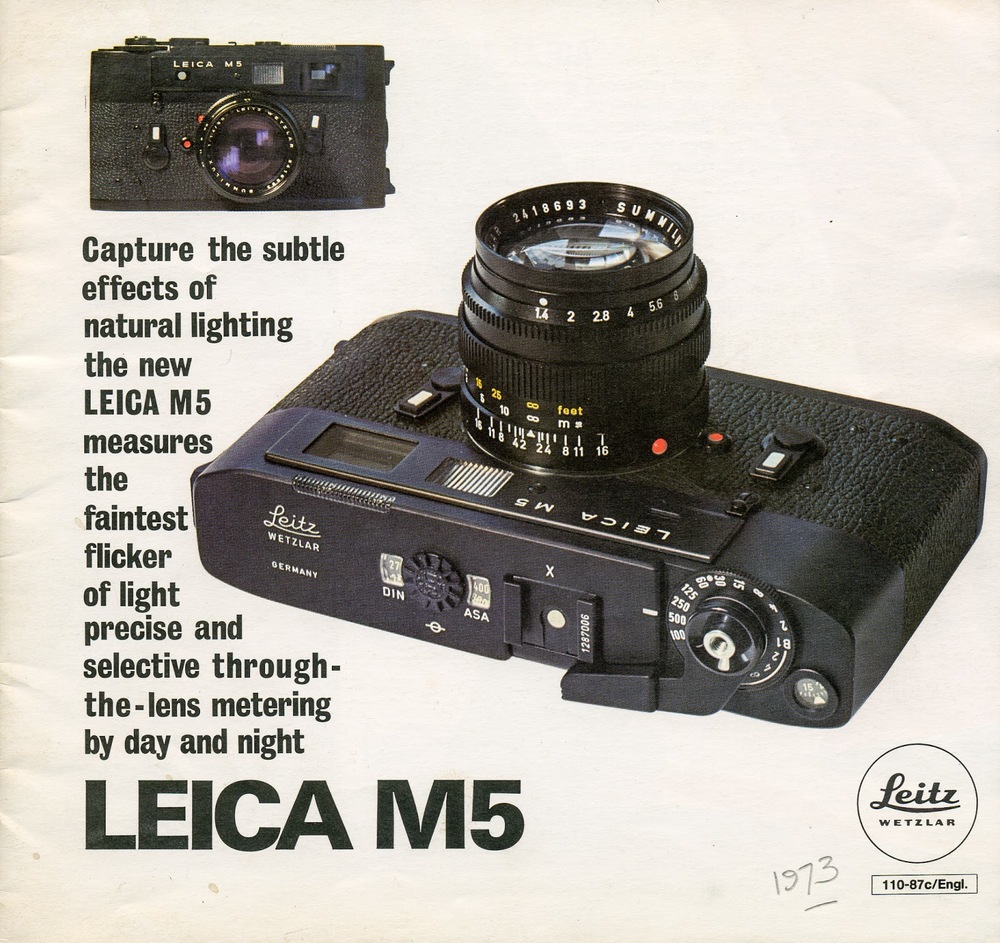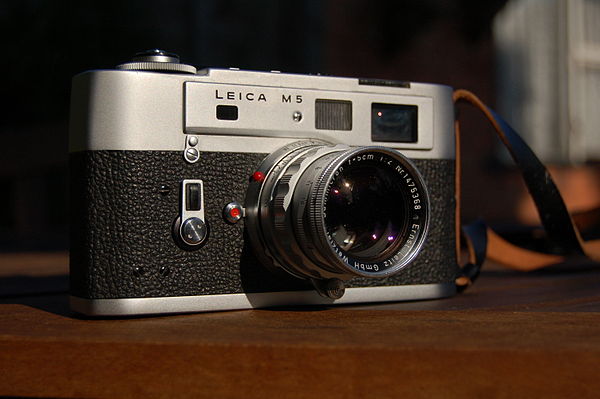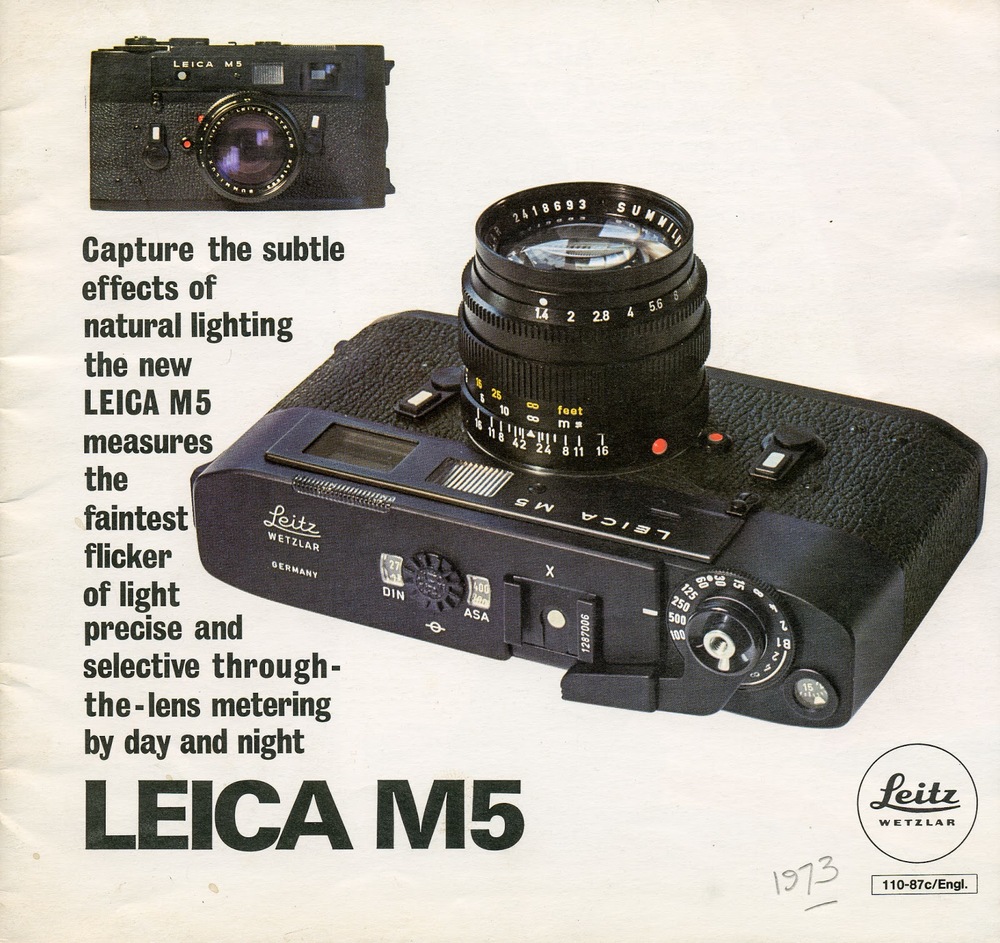
We’ve been writing a lot about film recently and the word Leica crops up in every second sentence. When you think of film cameras these days it is easy to be obsessed with the Leica name to the exclusion of other cameras that can do a similar job. Tim over at Leicaphilia has put together a list of the best buys among rangefinders that aren’t Leicas. There just one anomaly: The Leica film camera that is often unfairly dismissed for not being a true Leica, the oddball M5:

Yes, I know it’s a Leica…but it really isn’t, at least if you listen to the internet hive mind, most denizens of which have never seen one, let alone used one. The M5 is, in my mind, Leitz’s great, misunderstood masterpiece, the high-water mark of Leitz’s hand-assembled, cost is no object rangefinders. The M5 made its debut in 1971, the first M with an exposure meter – in this case, a TTL spot meter still the best meter ever put in a film Leica. Big, bright .72 viewfinder, .68 base rangefinder, well-thought through ergonomics unbeholden to the “iconic” M design.
Unfortunately, it flopped in the marketplace, no fault of its own, rather a function of broader industry trends (the move of professionals to SLR systems), boneheaded decisions by Leitz ( introducing the CL simultaneously at 1/5th the price), and, most importantly, rejection by Leicaphiles because it didn’t conform to the iconic M2/3/4 design. Which isn’t to say it wasn’t a brilliant camera – it was, and still is, even today, a better camera than the M6 that proceeded it. However, all but the most discriminating Leicaphiles continue to simply ignore the M5, as if it didn’t exist, usually because they’ve bought into the common view that it’s too big and too ugly, “not a real Leica M.” Bullshit. It’s the best metered Leica M ever made.
Read the full article at Leicaphilia and find out what bargain alternatives there are to Leica’s expensive rangefinders. Also you might be interested to read this article on the M5 at Japan Camera Hunter.


I agree Don that that it is a lovely camera to use, despite its size. Anyone who can tolerate a modern digital M or the Fujifilm X-Pro 2 should have no problem using it. The reason why the M3 suits me best is because of the 0.91 rangefinder/viewfinder which suits my not so good eyesight.
Thanks to Mike, I have sourced some 1.35 volt Wein cell batteries for the M5 from the Small Battery Company and they are on their way to me now. I hope they will work and will report on developments. They also seem to provide an adaptor which will convert the output of the modern 1.5 volt batteries back to 1.35 volts. It is also possible to adjust the ISO as Bill Rosauer suggests, but it would be nice just to have the correct voltage/reading starting off.
William
We Pro’s loved the M5, and most especially those in Germany and Japan, but then again unlike so many of our amateur brethren we did not care what it looked like, what mattered to us was not just the M5 was the Worlds first ever TTL rangefinder camera but also the best, and that accolade remained as being unquestionably true right up to the introduction of the M6.
The M5’s long base rangefinder remains better still in my view to than that of any ‘M’ Leica following including today’s latest digital M’s, and the M5’s far better design and much simpler and faster film loading plus far more rapid film re wind mechanisms quite simply eclipse those of such as the M6 or M7.
In short for any serious photographer the M5 remains a functional triumph rather than it just being yet another slave to fashion or wasted colectors item or worse,"Limited Edition"
I shoot mostly digital these days with a Leica M-E and M Monochrom CCD, but my Leica M5 is the one I am most attached to.
I had a black M5 I bought when new in about 1974 when I was a young lad in high school working at a Leica dealer. My dad kept that one. I bought another silver chrome one and had DAG install the framelines for the M4P in it. Still have that one and it was in regular use up until I gave up on film and went digital. It is very much like the 928, a wonderful machine misunderstood by all but a few. Same thing for the SL/SL2, which I still have several of too.
As I understand it, one needs to have the meter adjusted for the new battery type, as William pointed out the silver oxide button cells have gone the way of the Dodo. I never understood this as the number of these button cells discarded worldwide couldn’t have added up to half a desk waste bin yearly, while millions of flourescent tubes are discarded and are much nastier for the environment. Or you could find out how much the meter is off with the new cells and adjust the ISO accordingly.
Bill (and William), as I said I don’t have direct experience of the M5 but I did have a run-in with batteries for the MR viewfinder. I managed to buy an adapter that takes modern batteries and claims to adjust the voltage. If there is such a device suitable for the M5 battery (I have no idea what it is) then this could be an option. If you are interested I will look up the invoice and identify the supplier.
Thanks Mike
I had a nice black 3 lug one, with box and instructions, some years ago. It was an interesting experience. The metering ‘stalk’ system is wondrous to behold, as it is on the CL.
I always think that the M5 is to the M cameras what the Porsche 928 was to the 911 family. Porsche (and Leica) intended these 2 models to supplant the old campaigners but that didn’t happen in either case. Dead ends both.
But that’s not to say that the M5 and the 928 aren’t fine things in their own right. The good news is that you’ve much more chance of finding a good Leica M5 than a 928 these days……
Regards
John
Regards
John
Good analogy, John, you are right.
I picked up an M5 last year; 3 lug chrome in very nice condition. Unless you get the battery holder altered it will give you false readings with modern batteries. The original batteries were banned and are no longer made. I don’t think that it is a very big job to get the alteration done. My M5 has not been altered, but I have a CL from the same period which has been altered. They both have similar swinging sensors which are functioning in both cameras, apart from the battery issue already mentioned. The sensor does need to be checked to ensure that it has not broken before purchase, as it sits upon a delicate swinging plastic arm. There are some restrictions also about the use of collapsible lenses and making sure that you do not wind on while a lens is collapsed.
On to the important bit. Using external metering, the M5 does take nice photos in my experience and you can see the set shutter speed in the viewfinder. If the battery issue is fixed, the matching needles can give you a better idea of how far off you are from correct exposure than the red lights in the M6 and it also shows very clearly whether you are under or over exposed. It is a good bit larger than an M6 and is slightly larger than a Fujifilm X-Pro 2. Compared to the M6, there are plusses and minuses for both cameras. Neither of them is my favourite film M, which is the M3.
Subject to the points above, I would have no problem recommending the M5 to any Leica film user.
William
After writing the above article I got to thinking that the M5 is the one Leica camera I’ve never considered buying. Unfairly, I know, and Tim’s article just confirms this. Friends of mine, including Don Morley, have often said that the M5 was Leica’s finest rangefinder. Despite its relative unpopularity there is still a steady demand for good examples–Red Dot Cameras have a good one for sale at the moment for £599. Perhaps we should open our eyes and look beyond the M3s, M2s and M4s. When it comes to meterered photography, most people have an M6 at the top of their list, completely forgetting that the M5 was the first M rangefinger to feature metering. Even at £600 it is a couple of hundred less than a good M6 and is definitely worth taking a look at.
I seem to recall that Tim (I didn’t know that was his name), from Leicaphilia began his photography with an M5 when he was a student, he saved his pennies and got one for a knock down price because of its unpopularity… I believe he is still using it.
I have thought about your suggestion before, Ivor has had at least one of those on his website for a long time, but they do not work with my 50 DR Summicron, and I also understand that there is a battery issue, unless that battery that fits in the MR light meter works on the M5?
There is also this on Leicaphilia…
http://leicaphilia.com/tag/leica-m5/
A mighty read.
I remember reading about this, also. See my comments in response to Bill Rosauer (of the Leica Society of America, by the way) on batteries. I don’t know if it helps.